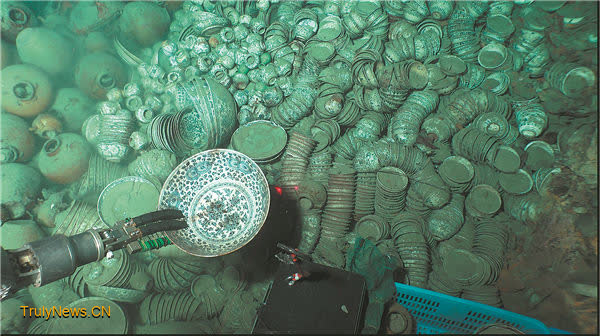
Teams utilize state-of-the-art technology to examine and study underwater archaeological findings to bring them to the public, Chen Bowen reports in Qionghai, Hainan.
In the waters 150 kilometers southeast of Sanya, South China’s Hainan province, lie two ancient shipwrecks enveloped in a shroud of mystery, resting beneath 1,500 meters of deep blue sea.
The shipwrecks, discovered in October 2022 and traced back to the middle of the Ming Dynasty (1368-1644), have been named by researchers as “Northwest Continental Slope No 1 and No 2 Shipwrecks in the South China Sea”.
The two shipwreck sites are relatively well-preserved and contain a wealth of cultural artifacts with a clear historical context, said Song Jianzhong, a researcher at the National Centre for Archaeology of the National Cultural Heritage Administration.
“This discovery not only stands as a major achievement in deep-sea archaeology within China, but it also holds global significance as a world-class archaeological find,” he added.
Archaeological investigations have confirmed that the core area of No 1 Shipwreck, housing the primary accumulation of the hull and a significant amount of neatly stacked cargo, spans 37 meters in length and 11 meters in width.
It is estimated that over 100,000 cultural relics, including porcelain, pottery, bronze, ironware, bamboo and wood are hidden on the spot, with much of No 1 Shipwreck still submerged under sand. Some of its exposed sections are buried by up to three meters of artifacts.
Some porcelain pieces have inscriptions and markings on them, such as “Fu” (happiness and blessing), “Taiping” (peace), and “Made by Wu Wen”, providing clues about the origin, production and possible ownership of these items.
Located about 20 kilometers away from No 1 Shipwreck, No 2 Shipwreck has been delineated into a core area and a scattered area. The core area, stretching 21 meters in length from north to south and 8 meters in width from east to west, showcases orderly stacked logs. In contrast, the scattered area presents an assortment of artifacts including pottery, shells and dispersed logs.
The stable physicochemical properties of seawater and the excellent acid and alkali resistance of ceramics enable these artifacts to be preserved underwater for centuries, said Li Jian’an, a researcher from the Fujian Museum.
“These artifacts are pioneering archaeological findings, serving as witnesses to the trade interactions along the ancient Maritime Silk Road in China. They offer tangible evidence that sheds light on China’s maritime history and the cultural exchanges between Chinese civilization and foreign cultures,” Song said.